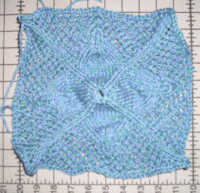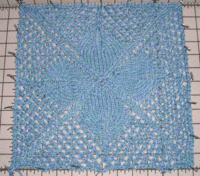
Tuesday, October 18, 2005
Compare and contrast (blocking)
 Remember last week's post about the adolescent square that just wouldn't come together? Last night I finished him (except for putting in ends) and blocked. At ten p.m. I started another square, and finished it (except for ends) at 10 p.m. tonight, a day that included going to work, an hour session with my accupuncturist/massage therapist, and another hour getting my spreadsheet in order to visit the endocrinologist on Thursday morning. I don't know how I did it, but this square just came together without any question and got itself made, before bedtime, before breakfast, during subway and bus rides, after lunch and on the couch after 9 p.m..
Remember last week's post about the adolescent square that just wouldn't come together? Last night I finished him (except for putting in ends) and blocked. At ten p.m. I started another square, and finished it (except for ends) at 10 p.m. tonight, a day that included going to work, an hour session with my accupuncturist/massage therapist, and another hour getting my spreadsheet in order to visit the endocrinologist on Thursday morning. I don't know how I did it, but this square just came together without any question and got itself made, before bedtime, before breakfast, during subway and bus rides, after lunch and on the couch after 9 p.m..First picture is the two of them together, also serving as a before and after picture of the wonders of blocking. The pattern is Beeton's Flower, out of Knitting Counterpanes by Mary Walker Phillips. I don't know what made her feel she had to invent new terminology to write her patterns, but, fortunately, there is a glossary at the front, so I was able to scribble it down in abbreviations I understand. If you find yourself feeling like you're knitting while patting your head and rubbing your stomach, you may want to do the same. It's a nice pattern and on size 4 needles, with Cascade 220 Quattro, loosely cast off, it came out about 10 inches unblocked, and blocked nicely to 12 inches square.
 Next is a close up, though somewhat blurry, of the unblocked square. Note the contrast between the largely stockinette center and the mostly lace outer edges, and how the stitches are taking up all 3 dimensions. The center really wants to bubble and wave. The trick to turning it into a flat piece is blocking.
Next is a close up, though somewhat blurry, of the unblocked square. Note the contrast between the largely stockinette center and the mostly lace outer edges, and how the stitches are taking up all 3 dimensions. The center really wants to bubble and wave. The trick to turning it into a flat piece is blocking.I happen to have a blocking board, just because I found it one day when I had the money for it and knew I would use it. There are plenty of substitutes, Knitty has an article from Winter 02 on blocking here that describes how to make your own. In the first picture, note also the t-pins and spray water bottle. Before beginning, one thing to make sure of is that your spray bottle is set to "spray" and not "stream" (ahem). You want a thorough but gentle mist to get the object and a bit of the surrounding countryside really, really damp, not a squirt that will move delicate items with the force of its stream.

I start with just a few pins, spray dampen the item, and then keep pinning and spraying. I find that dry items will stretch less easily than dampen items, and the name of the game with lace is to stretch it. Stretching while damp will also help flatten the differing gauge portions.
How much to pin? Enough. Avoid wavy scallops in edges that are supposed to be straight.
How much is enough? It's a matter of judgment.
How will I know? Develop some judgment.
The wonder with blocking is that you can always do it again, though getting the object back to smaller is tough.
I make a point of coming back every so often to redampen the item and surrounding countryside, and then letting it dry again. Lace is usually airy enough that it will dry in a few hours, though I tend to leave things pinned out for a day or two, just to let it know who's boss.











